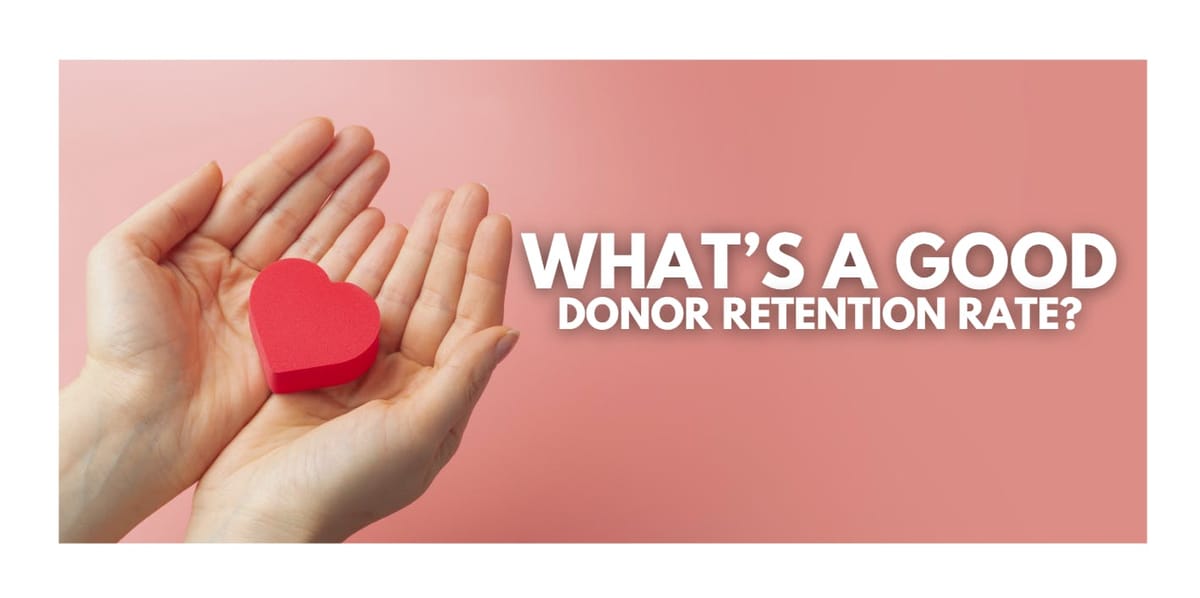Mastering the Art of Donor Retention: 5 Proven Techniques
Discover five proven techniques for improving donor retention, from personalized outreach to impactful storytelling.

Want to keep your donors coming back? Here's how to boost your retention rates:
- Get personal
- Tell impact stories
- Mix up your outreach
- Say thanks (a lot)
- Use tech to connect
Why it matters:
- It's cheaper ($0.20 to keep vs $1.50 to find new donors)
- Provides steady income
- Long-term donors often give more
The average nonprofit only keeps 35% of donors yearly. Let's fix that.
Quick Comparison:
| Technique | Key Benefit | Example |
|---|---|---|
| Personal touch | Makes donors feel special | Handwritten notes for top givers |
| Impact stories | Shows how donations help | Before/after stories of beneficiaries |
| Mixed outreach | Keeps donors engaged | Combo of email, mail, calls, and events |
| Frequent thanks | Boosts repeat giving | Thank within 48 hours, 7 times before next ask |
| Tech tools | Streamlines donor management | CRM to track giving history and preferences |
Ready to dive in? Let's boost your donor retention.
Related video from YouTube
Make It Personal
Want to keep donors coming back? Make them feel special. Here's how:
Know your donors: Split them into groups based on how much and how often they give. Then, tailor your approach:
| Donor Level | Gift Amount | How to Treat Them |
|---|---|---|
| Top Tier | $10,000+ | Write by hand, meet face-to-face |
| Mid Tier | $1,000 - $9,999 | Personal emails, board member calls |
| Entry Level | Under $1,000 | Special touch for first-timers and repeats |
Act fast: Thank donors within 48 hours. They're 4 times more likely to give again. Aim for personal notes within 72 hours.
Pick up the phone: A quick 3-minute call can boost retention by nearly 30%. Small effort, big payoff.
Show impact: Use real stories to show how donations help. Send a letter from someone your donor's gift helped.
Get creative: Go beyond basic thank-yous:
- Send a thank-you video
- Plan ways to engage top donors year-round
- Let kids pick their sponsors (like World Vision did)
Here's the kicker: Over 60% of nonprofits don't thank donors personally. Do it, and you'll stand out.
"Customizing donor interactions lets you humanize your work, build real relationships, and turn allies into ambassadors." - Howard Schiffer, Vitamin Angels Founder
2. Show Results Through Stories
Stories stick. They make donors feel good about giving. Here's how:
Focus on one person: Pick someone your work has helped. Goodwill Industries tells Nancy's story - a young mom who couldn't find work until Goodwill's programs changed her life.
Show the change: Kiva does this well with Lindiwe's journey:
| Before | After |
|---|---|
| Living in poverty | Running 3 businesses |
| Struggling at age 22 | Successful at age 22 |
Give credit to donors: Make it clear their money made a difference:
"Your gift built 12 wells this month." "You helped 200 kids get tutoring at 4 schools this year."
Use different formats: Mix it up with written stories, video testimonials, and before/after photos.
Share often: Tell these stories in fundraising emails, social media posts, and annual reports.
Fun fact: 65% of donors say they'd give more if they knew their impact. Stories SHOW that impact.
"Real stories. Real people. Real impact." - Case Alumni Association's CaseStarter project
3. Use Different Ways to Reach Out
Donors aren't one-size-fits-all. Mix up your communication to keep them hooked:
Email: Quarterly updates. Short and sweet:
- Wins
- Events
- How to help
Snail Mail: For the old-school crowd:
- Handwritten thanks
- Printed news (twice yearly)
- Holiday impact stories
Phone: Personal touch:
- Annual "thank-a-thon"
- Board member check-ins
Social Media: Two-way street:
- Share wins
- Ask questions
- Chat in comments
Face-to-Face: Non-ask events:
- Open houses
- Volunteer days
- Donor parties
| Channel | How Often | What to Share |
|---|---|---|
| Every 3 months | Updates, events, ways to help | |
| Snail Mail | Twice a year | News, thanks, holiday cards |
| Phone | Once a year | Thanks, quick updates |
| Social Media | Weekly | Success stories, behind-the-scenes |
| Events | 2-4 times a year | Open houses, volunteer days |
Pro Tip: Start small, grow as you go. Mix channels based on your size and donors.
Here's the kicker: Multi-channel donors give more. Gabe Cooper, Virtuous CEO, says:
"Even Gen Z donors appreciate receiving physical mail, highlighting the importance of not dismissing traditional channels."
4. Say Thank You Often
Saying "thank you" keeps donors happy and giving. Here's how:
Quick thanks: Send within 48 hours. Donors thanked fast are 4x more likely to give again.
Personal touch: Use donor's name and mention their gift.
Show impact: Be specific:
"Your $100 bought vaccines for two shelter puppies."
Mix it up: Try different methods:
| Method | When | Why |
|---|---|---|
| Handwritten notes | Big gifts | Feels special |
| Phone calls | Top donors | Direct, warm |
| Social media | Public thanks | Spreads word |
| Events | 1-2x yearly | Builds community |
Keep it going: Thank between gifts. Send birthday or anniversary notes.
Get creative: Small gifts work. One nonprofit sends Lifesavers candy, calling donors "lifesavers."
Rule of Seven: Thank seven times before asking again.
Amy Eisenstein, fundraising expert, says:
"Donors give to feel good. This includes feeling appreciated and knowing their gift made a difference to a cause they care about."
Remember: A simple "thank you" goes a long way.
5. Use Tech to Connect Better
Donor management software can supercharge your nonprofit's relationships. Here's how:
Track donor data: Keep everything in one place:
- Giving history
- Contact details
- Communication preferences
Segment your donors: Group supporters and target your messages.
Automate key tasks:
- Thank-you emails (within 48 hours)
- Birthday greetings
- Lapsed donor reminders
Go mobile-friendly: Make donating on phones a breeze.
| Feature | Benefit |
|---|---|
| Text-to-give | Quick donations |
| Mobile-optimized forms | Smooth experience |
| SMS updates | Keep donors informed |
Analyze your data: Spot trends and improve your strategy.
Integrate your tools: Connect your CRM to email, payment, and social media platforms. It saves time and keeps data consistent.
Pick the right software: Some options:
- HelpYouSponsor - Automate 90% of your sponsorship management tasks
- Bloomerang: Free version available. 10% higher donor retention rates.
- DonorPerfect: From $99/month. Great for small to mid-size nonprofits.
- Neon CRM: From $99/month. Custom video messaging.
But here's the thing: Tech is a tool, not a replacement for human connection. Use it to boost your personal outreach, not replace it.
Wrap-up
Let's recap the five key methods for keeping donors engaged:
1. Make It Personal
Tailor your approach to each donor. Segment your database for personalized outreach. This can boost annual donations by 25% when paired with multi-channel communication.
2. Show Results Through Stories
Donors crave impact. Share specific examples of how their support matters. 66% of millennials track results for most or all nonprofits they support.
3. Mix Up Your Outreach
Use different channels to keep donors engaged:
| Channel | Purpose |
|---|---|
| Updates and appeals | |
| Direct mail | Personal touch |
| Social media | Real-time stories |
| Events | In-person connections |
4. Say Thanks Often
Quick, genuine gratitude works wonders. 90% of in-memoriam donors value timely thank-you letters most.
5. Leverage Tech
Donor management software helps:
- Track giving history
- Automate tasks
- Analyze trends
These methods build stronger connections, show impact, and keep donors engaged long-term.
FAQs
What's a good donor retention rate?
The current average donor retention rate is 30.7%. But here's the thing: that's actually lower than in past years. Most nonprofits aim for 40% or higher.
Let's break it down:
| Donor Type | Average Retention Rate |
|---|---|
| First-timers | 20% |
| Repeat donors | 60% |
| Overall | 30.7% |
Here's a key insight: get a new donor to give just one more time, and their chances of sticking around jump by 40%. That's huge.
Some eye-opening stats:
- Bump up retention by 10%? You could boost your donor database value by 200%.
- Nearly 1 in 4 donors stop giving after just 6 months.
- Monthly donors are most likely to quit in January.
The takeaway? Focus on keeping those donors, especially the new ones. It's not just about getting donations - it's about building relationships that last.

